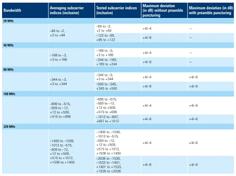Eye Diagram vs Bathtub Curve: Understanding the Differences
Advertisement
This page compares Eye Diagram vs Bathtub Curve and mentions the difference between Eye Diagram and Bathtub Curve or bathtub plot. Both the eye diagram and bathtub curves are used for signal integrity analysis.
Eye Diagram
 Image alt: eye diagram
Image alt: eye diagram
The eye diagram is obtained using an oscilloscope. Figure-1 depicts the eye diagram of data.
It is generated when digital data is sampled and applied to the vertical input of the CRO (Cathode Ray Oscilloscope), and the data rate is applied as a trigger for the horizontal sweep.
Different modulation types will have different eye diagrams. The eye diagram consists of multiple traces of data bits which are triggered by a bit clock.
Traces are superimposed which shows the envelope of amplitude and timing fluctuations.
In other words, the eye diagram shows the range of amplitude and timing deviations associated with data bits. The following measurements can be interpreted using the eye diagram:
- “Eye opening”: Indicates additive noise in the signal.
- “Eye Width”: Indicates timing synchronization and jitter effects.
- “Eye overshoot/undershoot”: Indicates peak distortion due to interruptions in the signal path.
Hence, an eye diagram with a large opening indicates a data stream with little amplitude and timing noise. An eye diagram with a small opening indicates the data is very noisy.
Bathtub Curve | Bathtub Plot
 Image alt: Bathtub curve or bathtub plot
Image alt: Bathtub curve or bathtub plot
Bathtub curves are created with a BERT (Bit Error Ratio Tester).
The BERT generates data which is passed through the DUT (Device Under Test). It measures transmitted data and compares for errors to determine the BER (Bit Error Ratio).
Here, the measurement location is swept across the unit interval (UI), and based on this, a BER plot as a function of UI is constructed.
This plot resembles a cross section of a bathtub, and hence the name of the plot is referred to as a bathtub curve or bathtub plot.
Figure-2 depicts a bathtub curve or bathtub plot of data.
It is found from the jitter PDF (Probability Density Function) (thick line) and TailFit™ extrapolation (thin line).
Once the jitter PDF is available, TailFit™ is applied in order to find the corresponding bathtub curve.
The bathtub range is a dimensionless number, i.e., BER. BER is the probability of bit errors.
The bathtub curve of timing errors is the integral or CDF (Cumulative Density Function) of the jitter PDF. TailFit™ can predict the probability of extremely rare bit errors. A Bathtub plot for BER as low as 10-16 can be found easily. This method takes a few seconds for measurement and analysis.
To plot a bathtub curve down to 10-12 BER using BERT requires many hours typically.
Advertisement
 RF
RF



